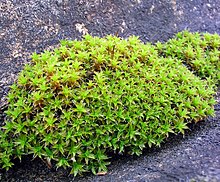| Syntrichia ruralis | |
|---|---|

| |
| Conservation status | |
 Secure (NatureServe) | |
| Scientific classification | |
| Kingdom: | Plantae |
| Division: | Bryophyta |
| Class: | Bryopsida |
| Subclass: | Dicranidae |
| Order: | Pottiales |
| Family: | Pottiaceae |
| Genus: | Syntrichia |
| Species: | S. ruralis |
| Binomial name | |
| Syntrichia ruralis (Hedw.) F. Weber & D. Mohr | |
| Synonyms | |
| |
Syntrichia ruralis, commonly known as twisted moss and star moss, is a species of moss with a cosmopolitan distribution. It occurs in North America, the Pacific, Europe, Asia, the Middle East, North and South Africa, South America, and Australia. It grows in many types of climate, including the Arctic, boreal areas, temperate areas, and deserts. It grows in tundra, coniferous forest, grassland, sagebrush steppe, and other habitat types.
This moss forms tufts of erect stems up to 4 centimeters tall. When it is wet it is bright green and the leaves are loose. When it dries the leaves wrap around the stem and it becomes reddish brown in color. It is dioecious. It also performs vegetative reproduction.
Though it occurs in many types of habitat, it is usually not a dominant species. The moss grows on many types of soil, but most often calcareous soils. It tolerates a variety of elevations and levels of sunlight. It may be a component in cryptogamic crusts. It helps to stabilize soil and reduce erosion. It can dry out and become dormant for many years, becoming metabolically active again after many decades of desiccation. It is used as a model organism in studies of desiccation.
References
- ^ Matthews, Robin F. 1993. Tortula ruralis. In: Fire Effects Information System, . U.S. Department of Agriculture, Forest Service, Rocky Mountain Research Station, Fire Sciences Laboratory (Producer).
- Oliver, M. J. (2010). Chloroplast genome sequence of the moss Tortula ruralis: Gene content, polymorphism, and structural arrangement relative to other green plant chloroplast genomes. BMC Genomics 11 143.
External links
| Taxon identifiers | |
|---|---|
| Syntrichia ruralis |
|
| Barbula ruralis | |